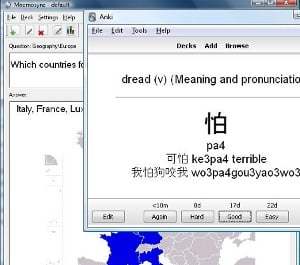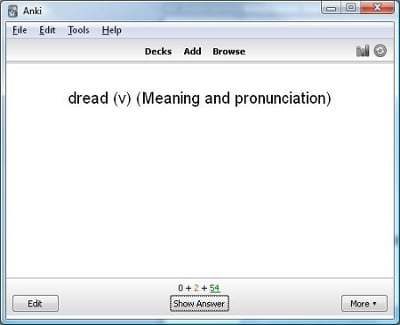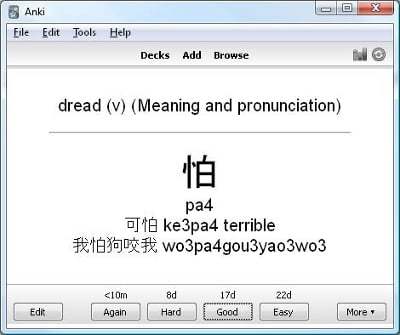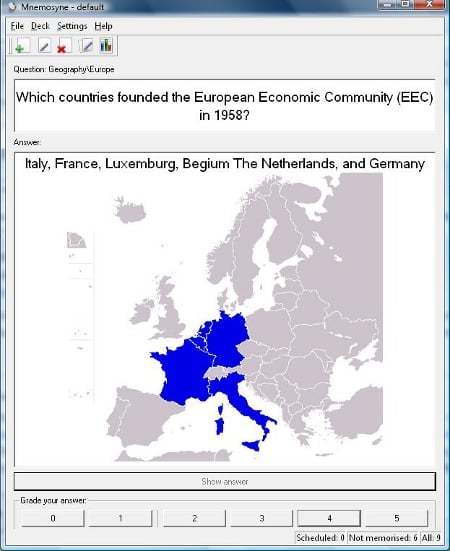 If you have read previous posts, you probably already know that I like using computer flash card programs to learn information in all kinds of subjects, including history, biology, geography, terminology, language vocabulary, and Chinese characters. Modern flash card programs are also known as spaced repetition software (SRS). Programs I have used extensively include the free open source programs Mnemosyne and Anki, and Vtrain (a traditional card box program).
If you have read previous posts, you probably already know that I like using computer flash card programs to learn information in all kinds of subjects, including history, biology, geography, terminology, language vocabulary, and Chinese characters. Modern flash card programs are also known as spaced repetition software (SRS). Programs I have used extensively include the free open source programs Mnemosyne and Anki, and Vtrain (a traditional card box program).
I believe spaced repetition software is very effective and should be a part of every learner’s toolbox. This post aims to shed some light on the history of spaced repetition software, and encourages you to try one of the programs. In future posts, I am going to take a more in-depth look at Anki 2, how to create good computer flash cards, and how to set up a system to allow for reviews and synchronization across multiple devices.
Why should you consider spaced repetition software to learn and review information?
If you have ever tried to maintain a larger amount of information accessible in your memory, you probably know that it does not just stay there without using the information or reviewing it several times.
What’s more, a multitude of research has shown that reviewing information by recalling it from memory (i.e., testing yourself) is among the most effective and versatile memory improvement strategies. By comparison, reviewing information by just rereading has been found to be generally a lot less effective.1
Practicing recall in a systematic and efficient way is easier said than done:
- The more information you learn, the more time you spend testing yourself, and the more time you need to keep track of what you know and what you don’t know. Obviously, we want to spend our time on information we don’t know.
- What’s more, we forget different pieces of information at different rates, so it is no easy feat to design an ideal review schedule.
Dr. Wozniak’s quest to learn for life rather than the next exam:
In the early 1980s, while studying for a graduate degree in Biology, polish scientist Dr. Piotr Wozniak became increasingly frustrated with the large amount of information he had to memorize and keep track of. His quest to learn, rather than just memorize for exams led him to create an ingenious flash card program called Supermemo. It was the first program which kept track of the difficulty of individual flash cards. It automatically adapted each individual card’s review schedule based on its review history and an assessment of its difficulty by the learner. To this day, Supermemo is still being improved. The website also contains a wealth of research and fantastic information on how to formulate knowledge for efficient learning and create good flash cards.
In 2008, Piotr Wozniak was featured in the fantastic Wired Magazine article “Want to Remember Everything You’ll Ever Learn?”
Despite being a very advanced piece of software, many people (including myself) have found Supermemo a bit difficult to use. Luckily, Dr. Wozniak has published his scheduling algorithm. Subsequently several free adaptive spaced repetition programs, including Anki and Mnemosyne have been created by enthusiastic programmers. Essentially all of them employ adaptations of the Supermemo algorithm.
This is how adaptive flash card apps work:
You create flash cards with pieces of information, such as facts, vocabulary etc. Every card has a question side and an answer side. Cards for different subjects can be placed in different categories (or decks) and labeled with tags. In all programs mentioned here, you can also use images, sound, and formulas on flash cards. I highly recommend using images whenever possible.
For every card you review, the program asks you to rate the card depending on how good you feel your recall was and reschedules the next review based on your rating and your previous review history.
To make this a bit more concrete, let’s take a look at Anki 2.
Anki 2 allows the user to rate a card as follows:
| Grade | Meaning | Consequence |
| Again | I couldn’t recall the information. | Card will be shown more frequently. |
| Hard | I could recall the information, but the review interval was probably a bit long. | The next review interval will only be slightly longer than the previous one. |
| Good | The review interval for the card was just right. | The review interval will be set to about 2.5 times longer than the previous time. |
| Easy | The review interval was too short. | The next review will be further in the future than for “Good”. |
Based on a base schedule and the grade you give a card, Anki automatically schedules the next review for that particular card. Every time you start the program, it automatically presents to you all flash cards due for review.
- Anki presents the question side of a flash card:

- You answer the question and click on “Show answer to see the answer side.
- Rate your answer for the card (Again, Hard, Good, or Easy) and the program automatically schedules the next review:

Mnemosyne, another open source flash card software, works pretty much in the same way (allowing the user to rate a card from 0 to 5):

Which flash card software should you use?
Now you are probably wondering which software you should use. My personal favorites are Anki and Mnemosyne. In my opinion Mnemosyne is a bit more user friendly while Anki is a lot more flexible. Supermemo is the most sophisticated software, and if you want to learn all there is to learn about adaptive spaced repetition software, you at least have to take a good look at Dr. Wozniak’s work. I am currently mostly using Anki 2 because I like its flexibility, and it allows me to review on a PC and my Android phone and relatively painlessly synchronize between the two. Anki has apps available for almost all major platforms.
| Program | Commercial / Freeware | Apps | Website |
| Anki 2 | Free (except iPhone, iPad) | Windows, Linux, Mac, Android, iPhone, iPad | www.ankisrs.net (Ankidroid 2 is currently in Beta) |
| Mnemosyne 2 | Free | Windows, Linux, Mac | www.mnemosyne-proj.org |
| Supermemo | Commercial, older versions available as freeware | Windows, iPhone, iPad | www.supermemo.com |
Notes:
- Roediger, Henry L., and Jeffrey D. Karpicke. “The Power of Testing Memory: Basic Research and Implications for Educational Practice.” Perspectives on Psychological Science 1, no. 3 (2006): 181–210. doi:10.1111/j.1745-6916.2006.00012.x.
 10 simple actions that can double your productivity
10 simple actions that can double your productivity
FREE guide of my top productivity hacks for subscribers to my free newsletter

Very interesting. I’ve been doing a bit of research on SRS. I’m starting to use Anki with my students – I teach English. And also trying to pick up Chinese! Really awesome tool!
Thanks for your comment IELTS Singapore.
IMO, Anki is a great tool for spaced repetition. I synchronize a lot between Anki 2 on a PC and Ankidroid. Your students could create good flash cards on a PC/Mac, and then review with their phone/tablet while on a train etc.